#Locust borer
Text
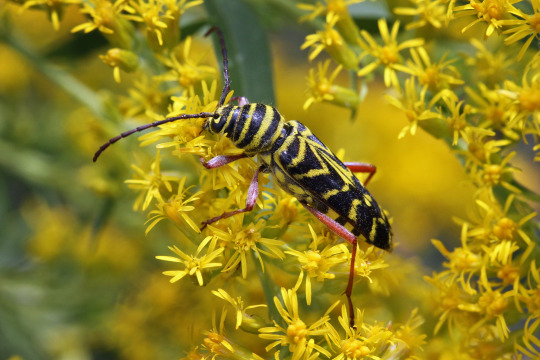
Locust borer (Megacyllene robiniae)
September 22, 2023
Southeastern Pennsylvania
#bug#bugs#photographers on tumblr#locust borer#beetles#coleoptera#bugblr#entomology#insects#insect#animals#nature#Megacyllene robiniae
272 notes
·
View notes
Text
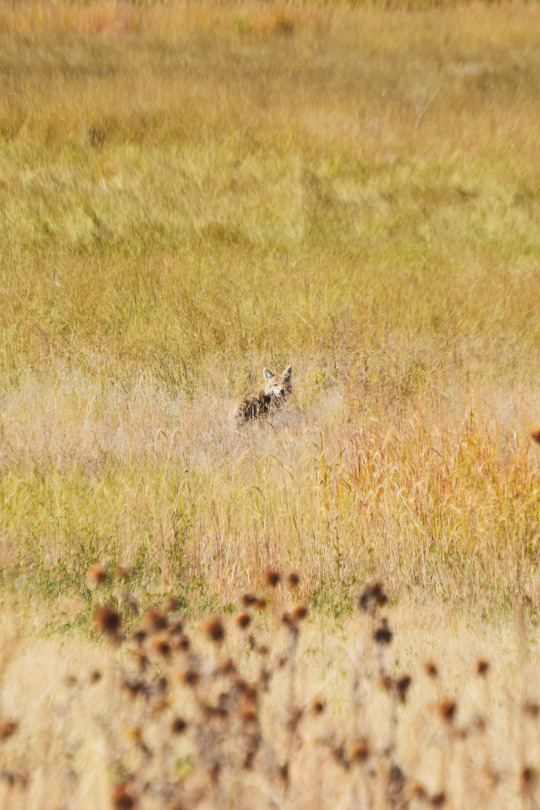



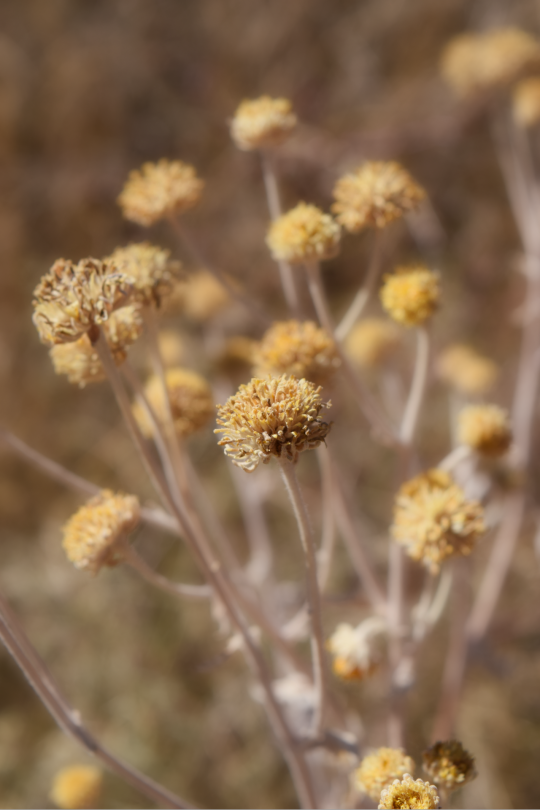

October in Rocky Mountain Arsenal National Wildlife Refuge. Commerce City, CO. Photos by Amber Maitrejean
#photographers on tumblr#landscape#nature#autumn#flora and fauna#coyote#insect#locust borer#colorado#rocky mountains#rocky mountain arsenal national wildlife refuge
23 notes
·
View notes
Text
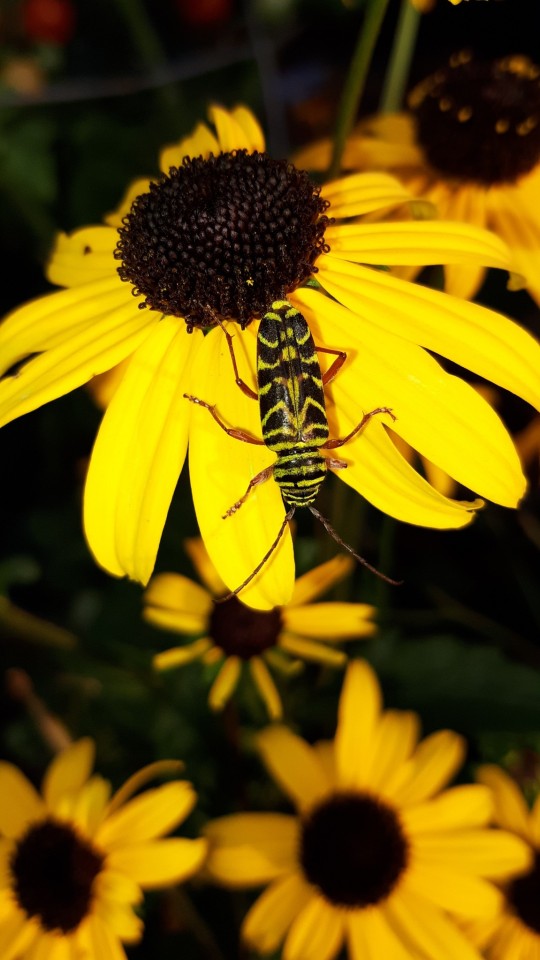
@nimblybimbly submitted: Stylish beetle matching the black-eyed Susans in the Spokane, WA. What’s it called? Thank you!
Beautiful! And they match the flower :) This friend is a type of longhorn beetle called a locust borer!
179 notes
·
View notes
Text
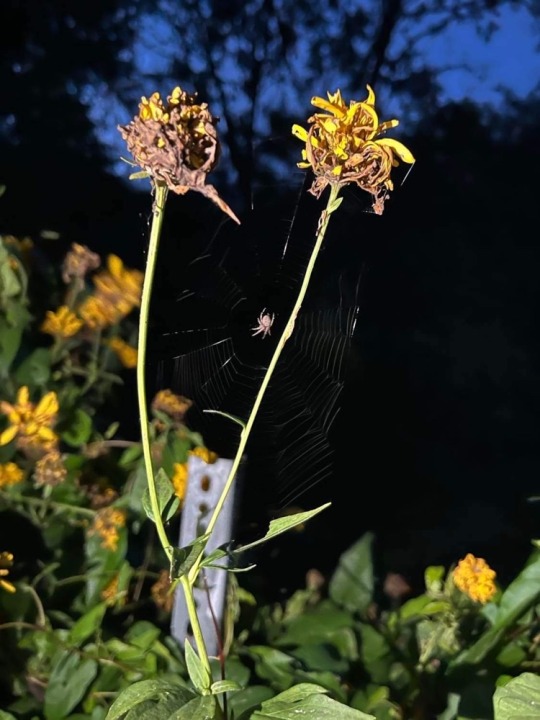
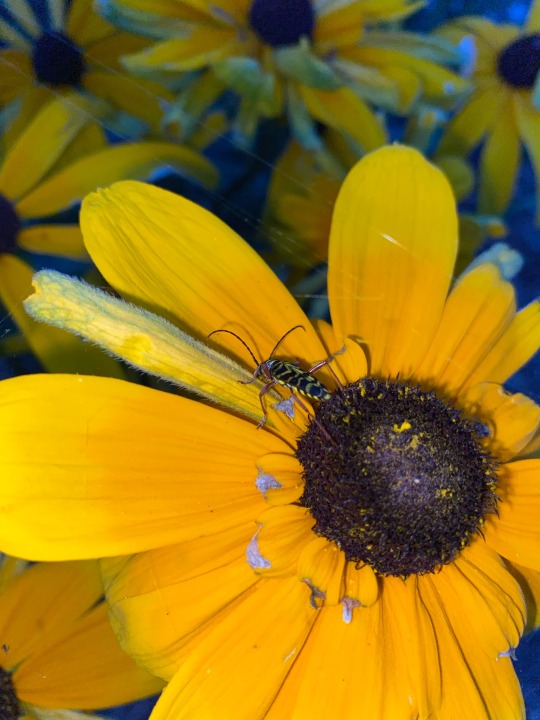
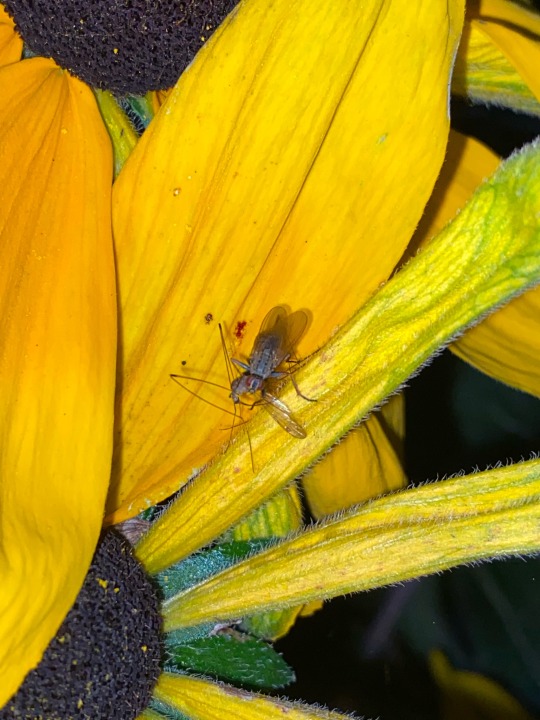
Some interesting fellows found during a late night walk by the lake
#insects#spiders#flowers#wildlife#nature#we actually watched the first little spider make that web#it was incredible it built it so quickly#thanks fly guy! I actually was really suprised to see a fly like that hunt!#grey cross spider#larinioides sclopetarius#pretty sure#araneae#araneidae#Locust borer#Megacyllene robiniae#cerambycidae#Scathophaga stercoraria#Scathophagidae#diptera#coleoptera#arachnids#north american species#my photos
9 notes
·
View notes
Text
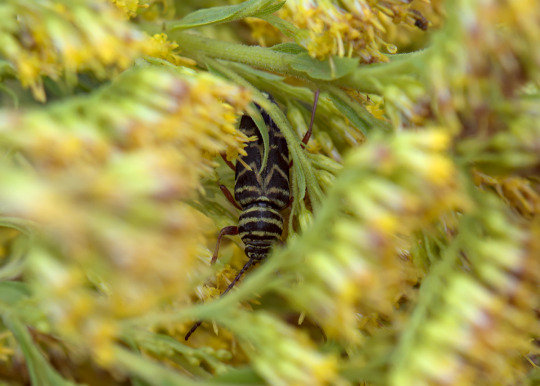
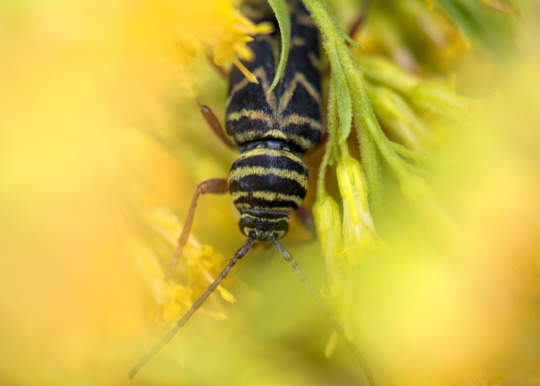
Locust Borer (Megacyllene robiniae)
3 notes
·
View notes
Text
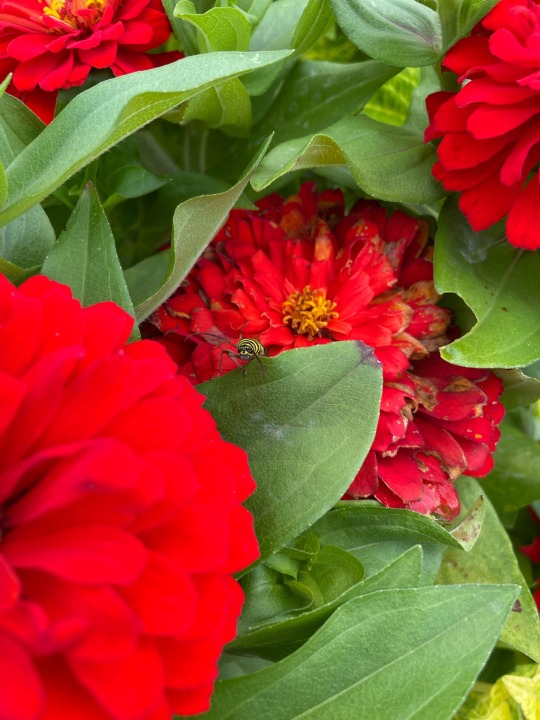
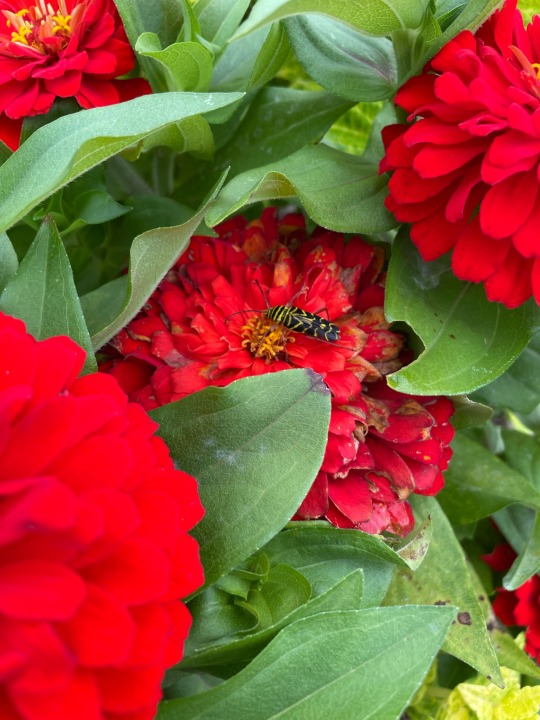
This stripey fellow looks like a locust borer (Megacyllene robiniae)!
0 notes
Text
22 September 2023 - Friday Field Notes
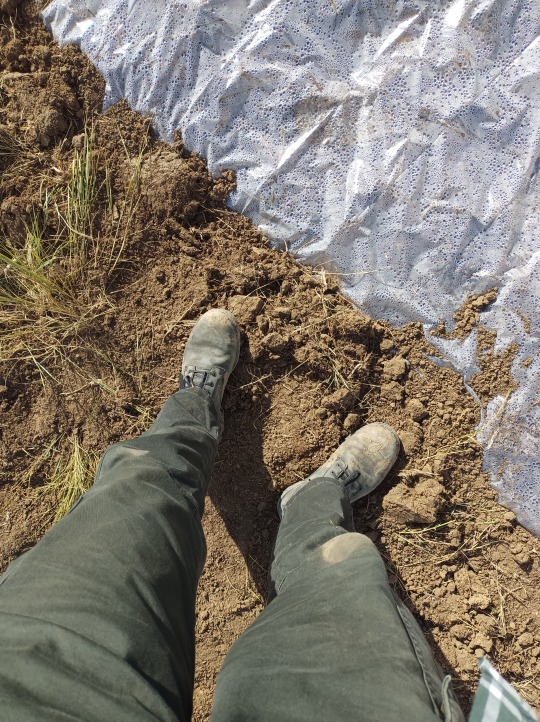
Field work is not glamorous.
It doesn’t matter what field you work in. Often times you’re outside for hours on end, the weather doesn’t cooperate when you need it too, you’re covered in sweat, in dirt, you’re overworked, you’re underpaid, your organization is understaffed, you don’t have the resources or the equipment you need to do the work, and trying to get people to give a shit and effect the change that needs to happen is a perpetual uphill battle that rivals Sisyphus’s eternal punishment. But you adapt, you improvise, and you do the work anyway.
Because it’s important. Because it matters. To me. To you. And to every living thing on this planet. You do it so things can grow and thrive.

Part of my job doing restoration work is removal and management of invasive species, like this Mullein pictured above. Now, Mullein is a plant that originated in Europe and Asia and was brought over to North America for cultivation purposes.
However, it didn't originate in the ecosystems in N. America, didn't evolve along with the local flora and fauna, it has no biological checks in the Great Plains to keep it from overrunning an area like it would in Europe or Asia. Not having any biological checks allows species to create monocultures, which isn't great because it reduces the overall biodiversity of an ecosystem, making it less robust and unable to support the vast array of wildlife you should find in a given area. Some species in the Great Plains do utilize the Mullein as a resource, but again, since it didn't evolve here many species are essentially losing food and habitat because of this plant.
Monocultures also reduce the effectiveness of a habitat's ecosystem services that help support life for all living organisms. Including us. Clean air, clean water, nutrient rich soil to support the growth of food, capturing carbon to sequester to reduce climate change... All reliant on biodiversity. All reliant on populations of native plants.
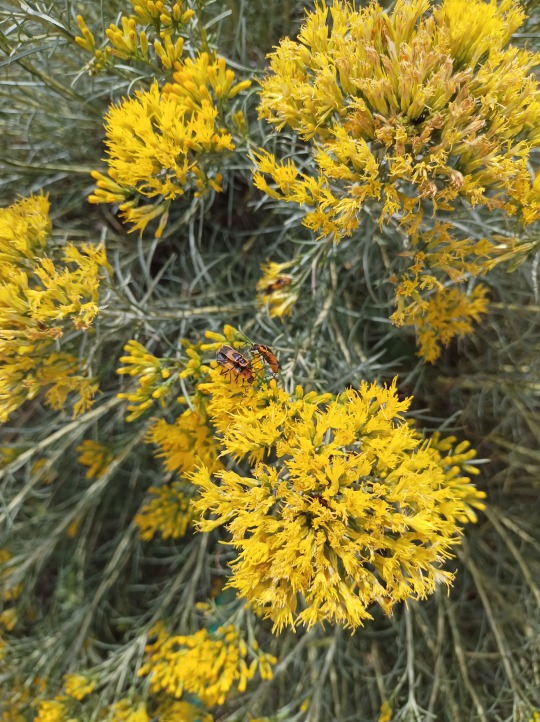

It's not enough to just remove invasive species though. You can't take something out, without putting something back in. Good land management and stewardship practices should also restore ecosystems. Rabbitbrush and Rocky Mountain Bee Plant are both species that are native to my local area, and are a resource for all manner of species.
And that Bee Plant, we planted that last season. It was the only one that grew, but look at all the seed pods on that thing! Hopefully those seeds will go on to make even more Bee Plants and support even more wildlife!
I watched this documentary series last week for work and I'd highly recommend it. It's about the native seed supply chain in the western United States for restoration efforts. A really large area, that needs as much helps as it can get.
https://ser-insr.org/native-seed-film - You can watch it in sections, or they have a couple of different lengths depending on the time you have. But if you only have 12 minutes to give, for sure watch the introduction.
Now, I'd like to point out, these large scale efforts are important, but restoration efforts don't have to be big or elaborate. If you have a spare planting pot or a backyard, you have the ability to restore native habitat. You can bring those ecosystems to you. And it doesn't necessarily require you tearing out your whole yard or sacrificing the plants you do grow.
It may require a bit more homework (you're gonna have to research what plants are native to where you live), and some trial and error, but there are a lot of gorgeous native plants out there that require very little work once they're established compared to "traditional" garden plants.
Humans have carved out huge swathes of land for our own purposes, often to the detriment of other living things and ourselves. We've destroyed entire habitats and ecosystems due to human vanity and simply walked away. Cut our losses. Those habitats and ecosystems are lost. But the land is not gone. And who's to say all those things that are lost can't be found.
It's not easy work, but with some compassion, and a little bit of knowledge, and the willingness to be patient, perhaps we can weave the land back together. Not the way it was, but rather better.
A ghost can dream, right? And perhaps this Pronghorn does too.

It's hard to appreciate the subtle beauty of the prairie. It's not a forest. Not the ocean. Most people might only see grass and not see the richness. The diversity. But I've done a shit-ton of digging this week to try and install a native plant garden.
Field work, manual labor and sweating outside with a shovel, is not glamorous.
But I'm doing this so people can hopefully see the beauty of the prairie, so they can see the beauty in the land around them and perhaps consider planting some native plants of their own. So every living thing out here, big or small, can have a home.

And here's a Megacyllene (sp?), probably a Locust Borer Beetle. It has wasp stripes to dissuade predators from trying to eat it.
#nature#field notes friday#restoration work#short grass prairie#plants#habitat restoration#native plants#locust borer beetle#pronghorn#rocky mountain bee plant#rabbit brush#mullein#land management#land stewardship#native seed restoration#little ghost on the prairie
27 notes
·
View notes
Text
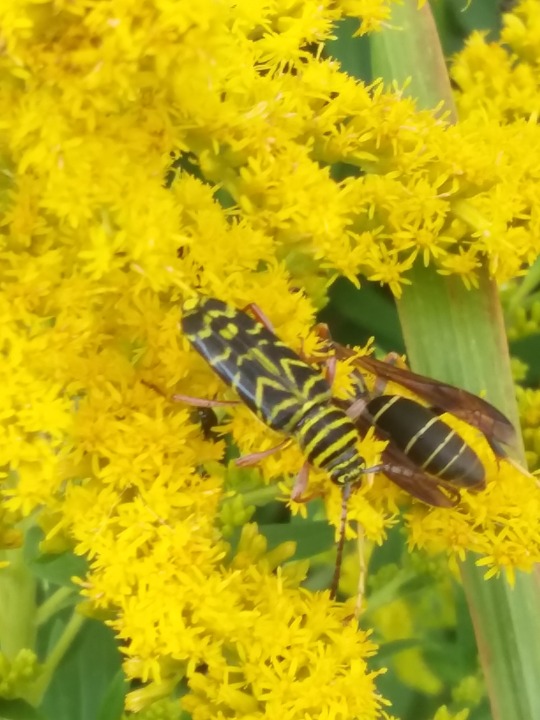
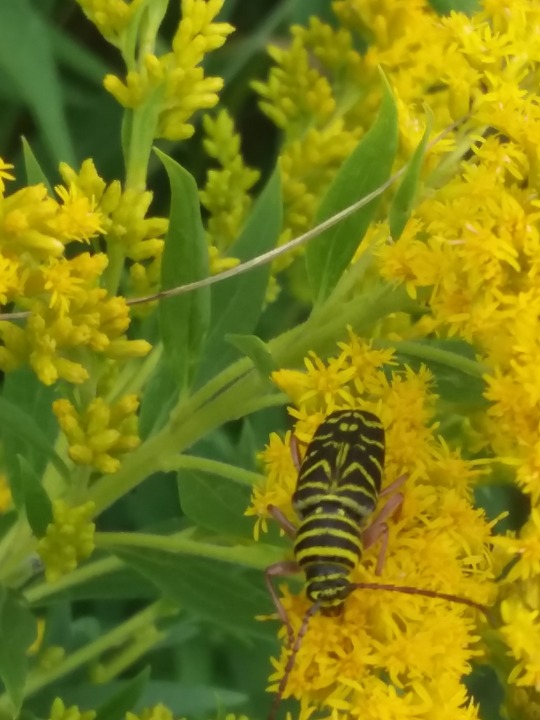

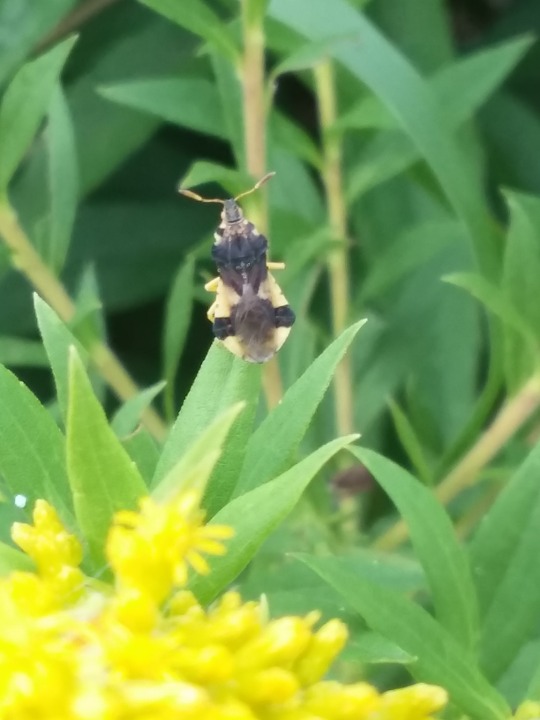
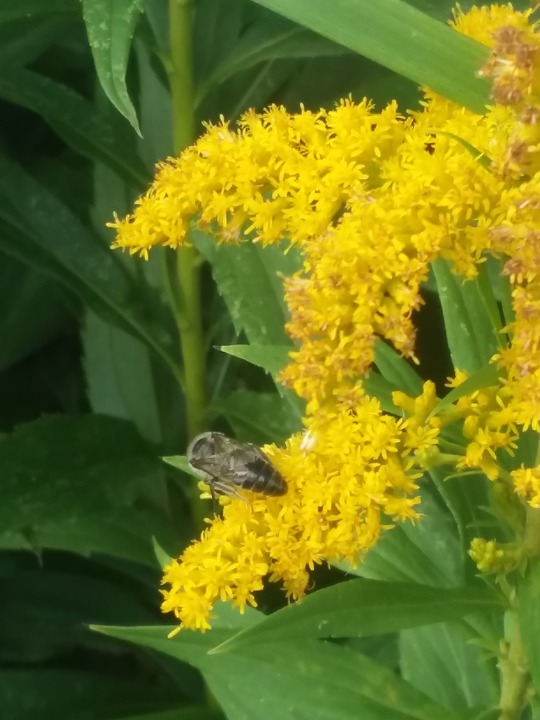

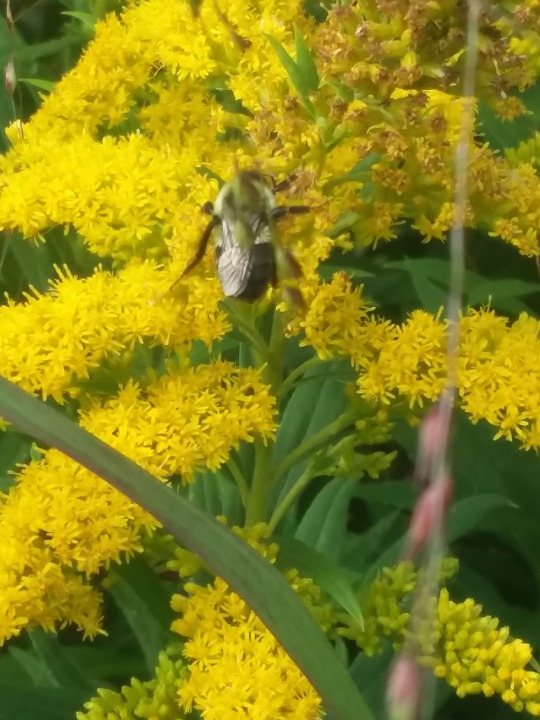
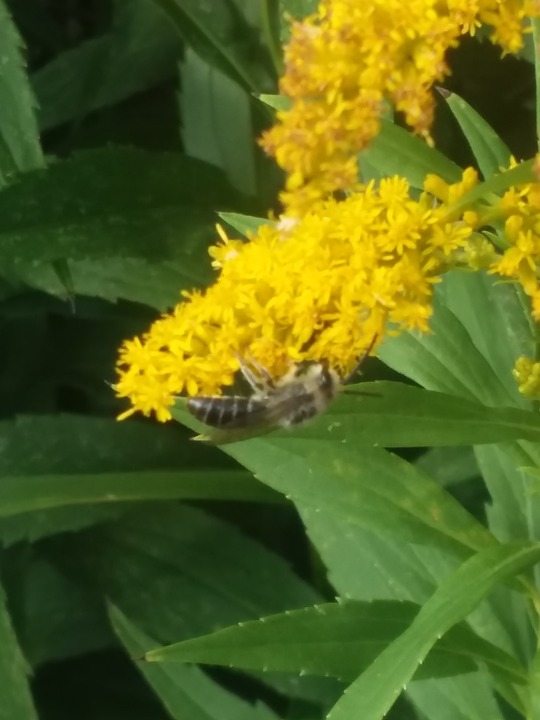
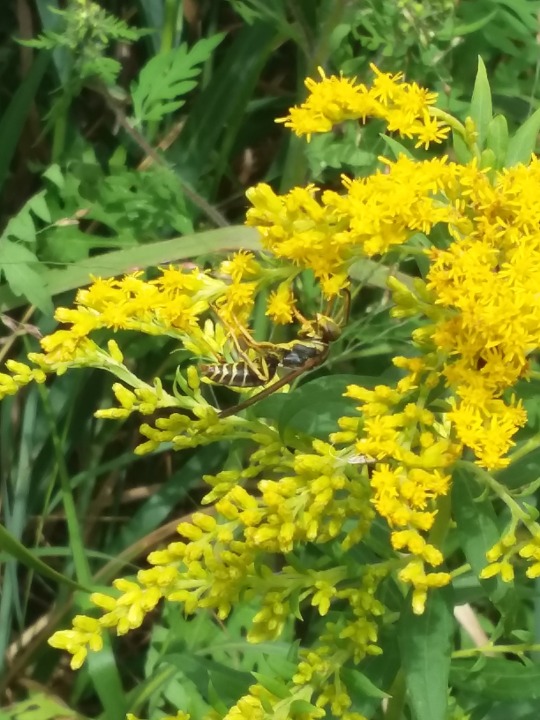

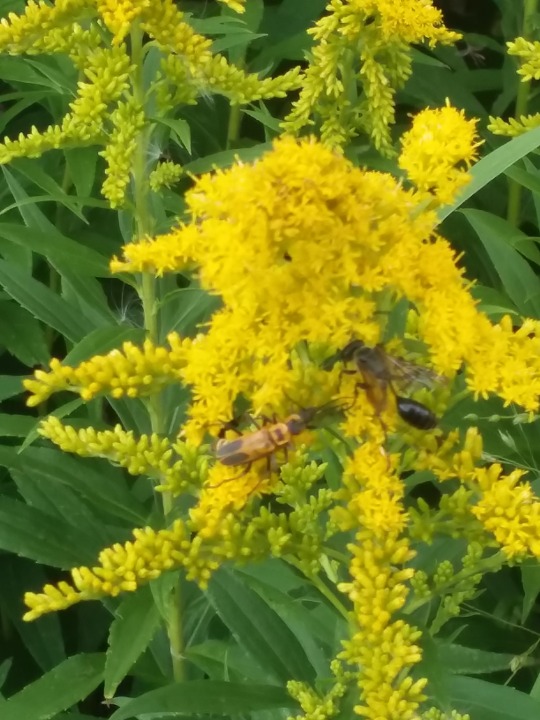

The Golden patch is the place to between July and September if you're a bug.
The small flat bugs with raptorial mantid like arms are Jagged Assassin Bugs, they love hanging out in the Golden Rod and Thistle to snag a snack.
The long yellow stripy beetle is a Locust Borer beetle.
So many native New York Bees and Vespids, which absolutely loved my flower print shirt. It really let me get close and get some interesting shots... it also made me some very curious wasp friends that followed me for a while.
#golden rod#Bugs#locust borer beetle#native bees#native wasps#beetles#nature#photography#dont wear floral prints around wasps unless you want a bunch of new stingy friends
2 notes
·
View notes
Note
i am SO sorry about the state of your notifications right now, for what it's worth the original post actually made me cry because of how beautiful and eloquent and moving it was. some of these responses are just..... absolutely bananas lmao. anyway as a distraction: what are your top five species of bug that you wish more people knew about? worldwide, local to you, whatever you want!
Hmm I would say... Dogbane beetles, Longhorn bees, Hummingbird Clearwing moths, locust borers, wheel bugs
Some of these are genera rather than species. Oh well.
85 notes
·
View notes
Text
November 24th, 2023
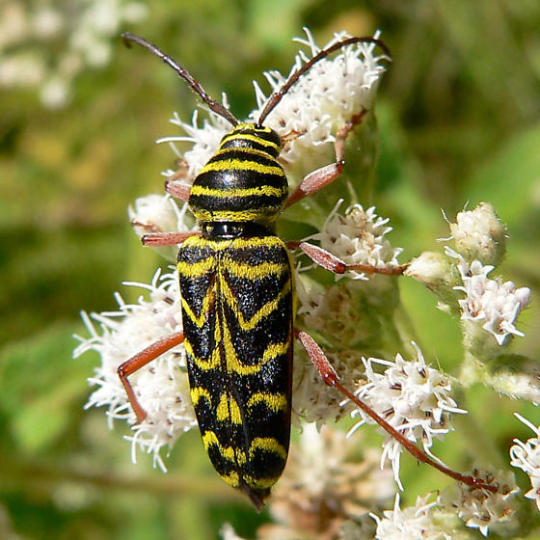
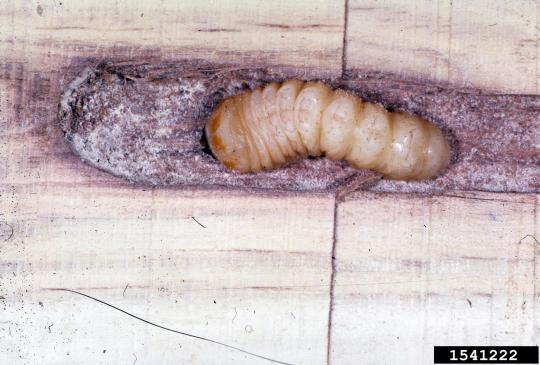

Locust Borer Beetle (Megacyllene robiniae)
Distribution: Originally found only in the northeastern USA, but now found throughout the USA and southern Canada.
Habitat: Usually found in areas where the black locust tree Robinia pseudoacacia is present, especially where goldenrod can also be found; usually uncultivated fields and meadows.
Diet: Larvae feed on woody tissues of the black locust tree; adults feed on the pollen of goldenrod flowers.
Description: The locust borer beetle is a serious pest of black locust trees, singlehandedly destroying the value of what is otherwise an extremely valuable timber tree. Female beetles lay their eggs near wounds or in crevices, where newly-hatched larvae will overwinter. In the spring, they bore into the tree bark, forming tunnels 10 centimetres long and 0,7 centimetres wide. These tunnels serve as an infection site for fungi, which can infect the trees and render them stunted and diseased. Trees suffering from drought and those growing in open areas, like roadsides, or in eroded or nutrient-deficient soil are especially vulnerable to attack. This species isn't known to feed on any other tree species.
(Images by 1) Marcie O'Connor (adult), 2) Lacy L. Hyche (larva) and 3) James Solomon (damage))
11 notes
·
View notes
Text
Saw a Solidago today that was crawling with yellow and black insects.

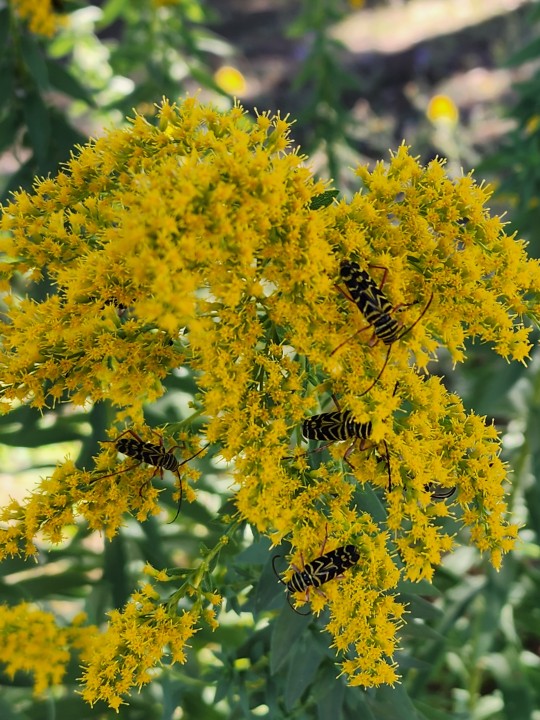
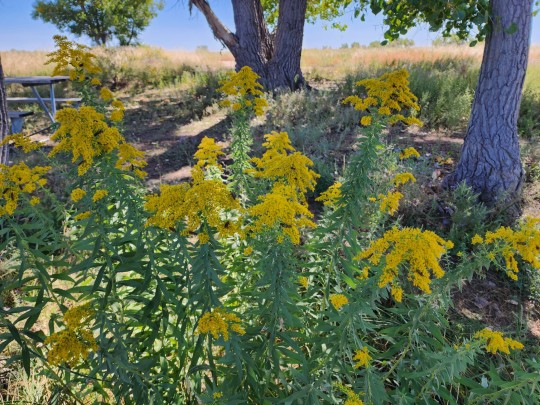
Image ID. Some yellow goldenrod flowers with a bunch of bugs on it. End ID.
At first I thought it was just the beetles (locust borers, Megacyllene robiniae), but there were also a couple wasps (Polistes sp. and somebody from Halictidae) and wasp mimic hover flies (probably Spilomyia).

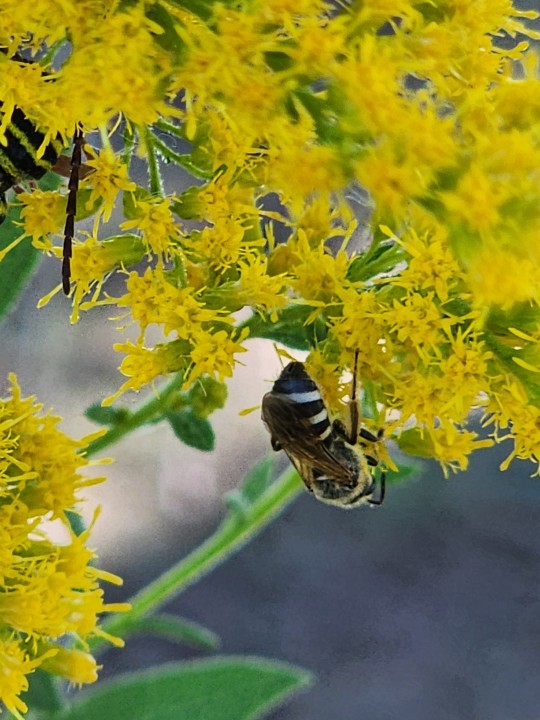


Image ID. Closer shots of the bugs in question. All are striped in bright yellow and black, but they are a beetle, a bee, a fly, and a wasp. End ID.
#insects#harper talks#solidago#wasps#hymenoptera#coleoptera#beetle#mimicry#biology#diptera#flies#goldenrod
7 notes
·
View notes
Note
Trick or treat!
ha TRICK

LOCUST BORER (Megacyllene robiniae) BE UPON YE
6 notes
·
View notes
Text
@shuushaming submitted: Hi, I found these guys a couple weeks back in Natrona County, Wyoming. Thought they were neat but I've never seen either of them before. Any idea what they are? Thanks, and have a lovely day!!
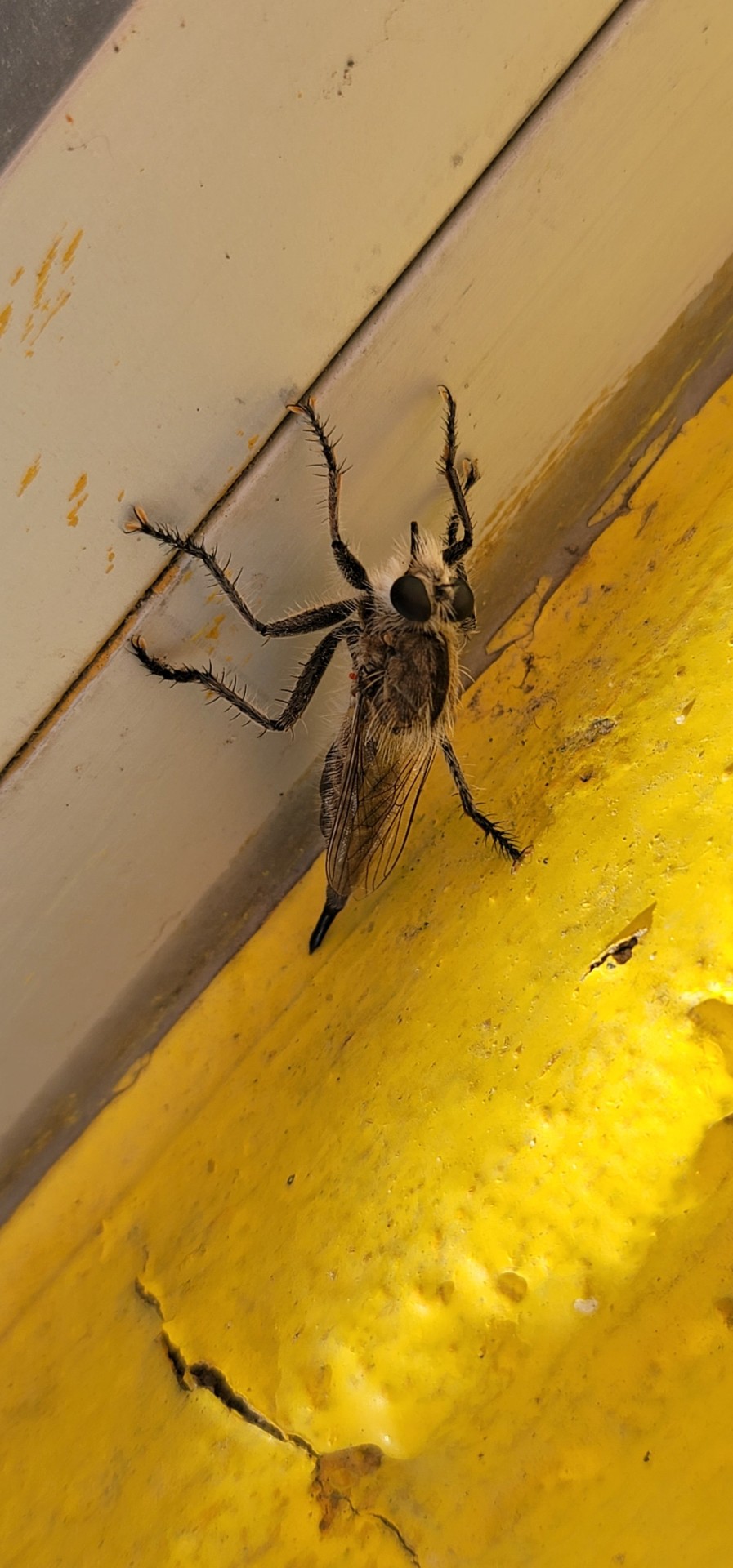

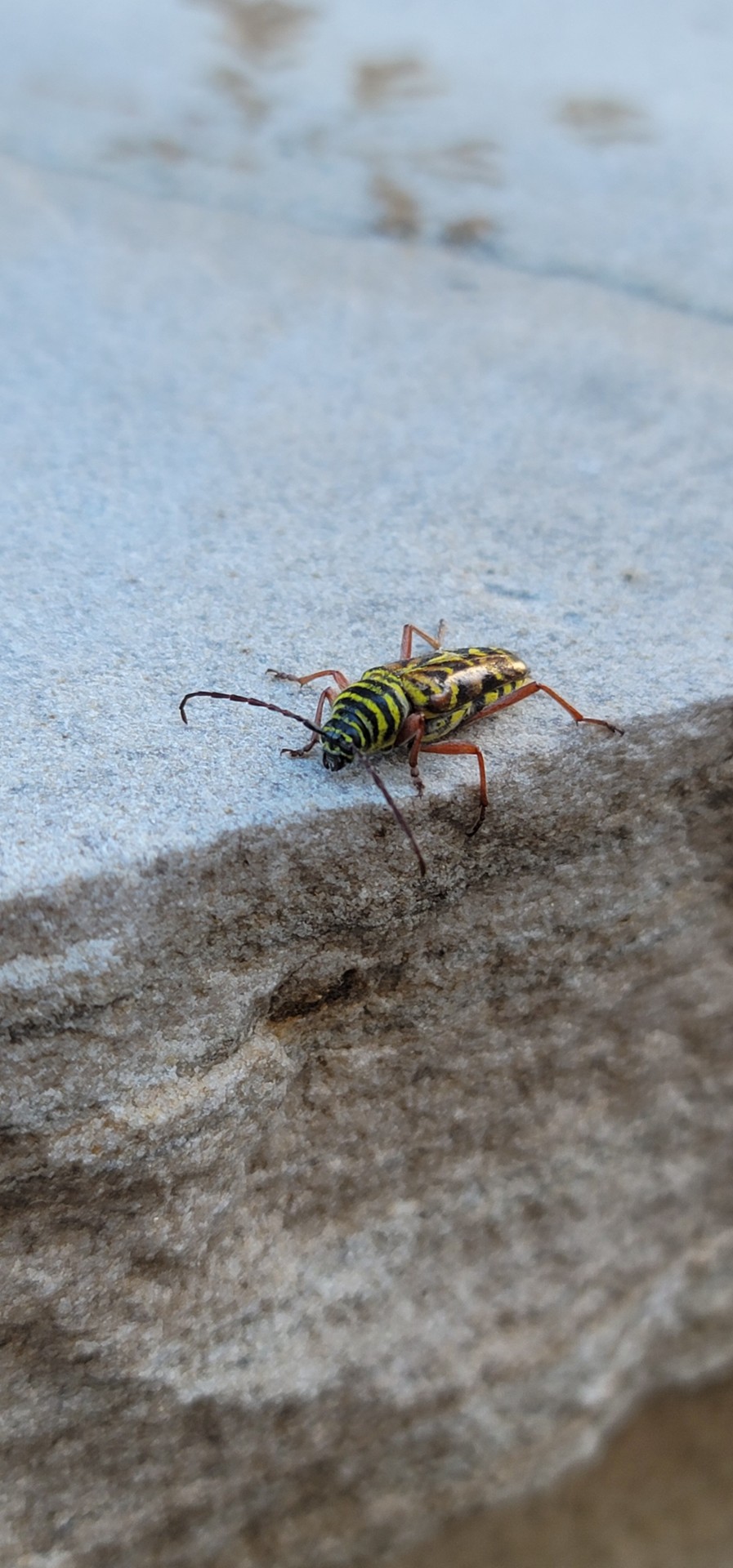

Helloooo the large fuzzy fella is a robber fly and the wasp mimic beetle is a locust borer, which is a type of longhorn beetle :)
60 notes
·
View notes
Photo








Sculptured Resin Bee - Megachile sculpturalis
A tip for when you bug hunt around your neighborhood: take note of the areas where insects tend to gather, particularly if the areas are home to specific or “more unique” insects. There may be something significant about that area that is advantageous for those insects to gather there, and thusly it’s very likely that you might see those insects again there, depending on the time of year, the weather and even surrounding plants. This information can help when creating your own insect habitats and bring in insects you wish to see in your area. It’s also a good way to measure consistency year after year: if the insects don’t return and stay away, it’s wise to think on what has changed. There are specific sites in my area where specific insects gather in populous amounts due to the area’s conditions. One particular bed of flowers in the neighborhood brings Five-Banded Thynnid Wasps in the summer; the goldenrod flowers near the creek’s black locust trees always bring Locust Borers near the end of summer; and one particular bed of flowers seems to be alluring to this particularly large Leafcutting Bee. I’m super happy (and lucky) to have seen them again and I’ll be checking in on the flower bed again next year between mid July to mid August to see if they return then (though Bugguide has observed them active from June to September). I’ve got to work on getting the timing just right!
Of course other pollinators, social Bees in particular, also frequent these flowers, so there’s always an opportunity for some photography and to observe the behaviors and habits of our Bee friends. If I find the Sculptured Resin Bees here again next year, perhaps it may be possible to track and find one to its nest. Aside from feeding themselves, pollen needs to be gathered for the young Bee larvae which will be a provision for them until the next year (they overwinter inside a hollow cavity) nest. Even if that’s not the case here, perhaps following these Bees may lead me to the flowers they obtain pollen from; the flowers here seem to be solely providing nectar to the feeding males. Perhaps female Resin Bees are found elsewhere on flowers more suitable to their needs? I suppose I’ve have to expand my area of search to see what I can find. In any case, if you by chance discover one of these Bees, you can tell males and females apart by markings on their face and the shape of their abdomen. Females have no patches on their face and an abdomen that tapers to a point. Males have facial patches and a blocky abdomen, and since they lack a stinger are safe to handle. Having said that, since their jaws are designed to scrape resin and sap from trees, best not to pester them or prod their face.
Pictures were taken on July 30, 2022 with a Google Pixel 4.
#jonny’s insect catalogue#ontario insect#bee#sculptured resin bee#leafcutting bee#hymenoptera#insect#toronto#july2022#2022#entomology#nature#invertebrates#arthropods
14 notes
·
View notes
Note
A list of moths from my state that are either interesting to look at, have interesting names or both!! Sorry for it being so long
Abbreviated button slug moth
Afflicted dagger moth
Ailanthus webworm moth
Arcigera flower moth
Beautiful wood nymph moth
Black waved flannel moth
Blackberry looper moth
Buck moth
Clymene haploa moth
Confused eusarca moth
Confused woodgrain moth
Dot-lined white moth
Drab prominent moth
Eight-spotted forester moth
Elder shoot borer
Gaudy sphinx moth
Giant leopard moth
Gold moth
Green arches moth
Hag moth
Harnessed tiger moth
Hera buck moth
Honey locust moth
Ornate bella moth
Painted tiger moth
Parthenice tiger moth
Pearly wood-nymph moth
Pickle worm moth
Regal moth
Sad underwing moth
The badwing
The beggar
The betrothed moth
The gem
The halfwing
The Hebrew
The joker
The scribbler
Zebra conchylodes moth
Zig-zag furcula moth
I'll be sure to check them out later.
5 notes
·
View notes

